Processes.Collisions¶
The element Collisions of the Processes branch, defined by CollisionsType, contains one or more CollisionalTransition elements.
CollisionalTransition¶
The complex element CollisionalTransition provides:
- the physical information to fully describe any collision involving photons, atoms, ions, molecules and elementary particles such as electrons or photons, and any particle solid interaction (PSI) - reaction process type - reactants - intermediate states if known - threshold if applicable
- the numerical data, either in a tabulated form or described by a fit function, or both, in DataSet elements.
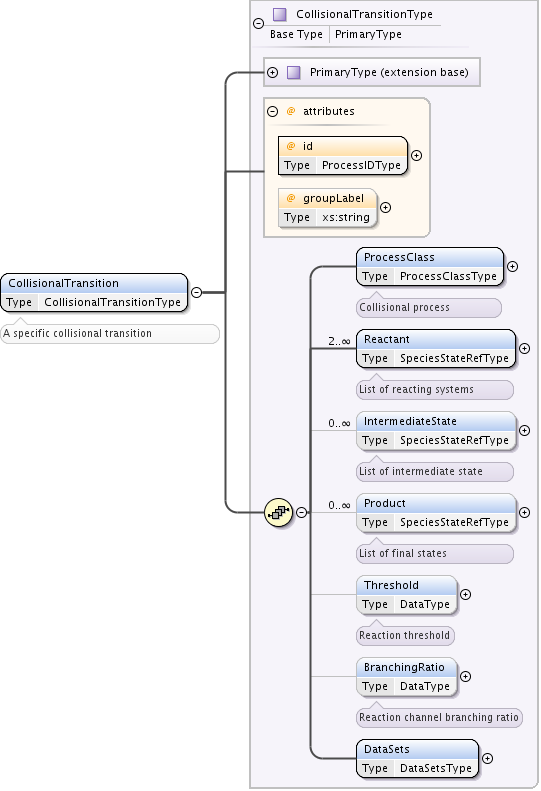
Element CollisionalTransition, defined by type CollisionalTransitionType, extends PrimaryType, adding following attributes and elements:
- mandatory id attribute of type ProcessIDType,
- optional groupLabel attribute of type String, used to indicate arbitrary process groups;
- optional element ProcessClass defined by type ProcessClassType, that allows to define groups (classes) to which process belongs. See the referenced paragraph ProcessClass for the complete description.
- mandatory list of Reactant elements, defined by SpeciesStateRefType, having two or more elements,
- optional list of IntermediateState elements, defined by SpeciesStateRefType.
- optional list of Product elements, defined by SpeciesStateRefType. Reactants, intermediate states and products are defined by references to species or to states, or both of them, using SpeciesRef (StateRefType) and StateRef (SpeciesRefType) elements. See Species chapter for a full description of all possible states.
- optional Threshold element, of DataType, giving the reaction threshold, i.e. the minimum energy required to initiate a reaction. This kind of data is needed in using data such as rate coefficients.
- optional BranchingRatio element of DataType. In case of chemical reactions with the same set of reactants and different products, this element may be used to indicate the relative probability of reaction. The sum of all BranchingRatio values for a given set of reactants must be equal to 1.
- mandatory DataSets element, that provides numerical data for a specific reaction. It is an unbounded sequence of DataSet elements, therefore different datasets may be provided for the same reaction. Datasets differ at this level by their dataDescription attribute, such as rate coefficients or cross sections for collisions, reflection coefficients or mean penetration depth for PSI data, etc.
ProcessClass¶
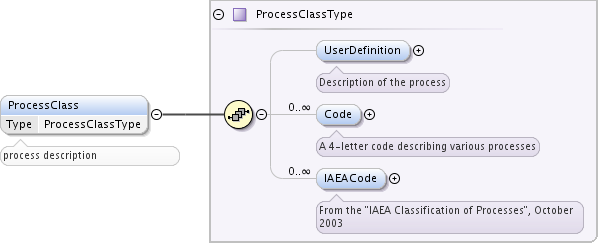
ProcessClass block is used to characterize process by the group to which it belongs, for example to indicate a chemical reaction, inelastic collision or hyperfine transition. Main element ProcessClass has the following optional child elements:
- UserDefinition for arbitrary string description of process,
- list of Code elements, defined by CodeType, identifying the process using XSAMS-specific 4-letter XSAMS Process Codes. Taking examples for common processes, excitation has one value exci and dissociative recombination has two values diss and reco.
- list of IAEACode elements, defined by IAEACodeType, identifies the process using IAEA DCN codes from [IAEAProc]. The initial purpose of IAEA codes was the development of search engines for atomic and molecular data. Processes, represented with a three-letter code, are classified in four categories: electron collisions, photon collisions, heavy particle collisions and particle surface interactions
DataSet¶
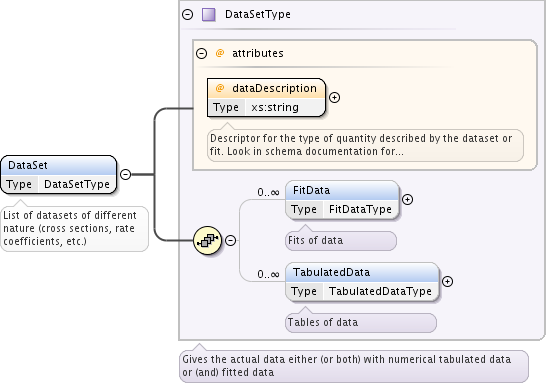
Element DataSet, defined by type DataSetType, provides numerical data as tabulated data ( TabulatedData element) or as the parameters values and validity limits of a fit function (FitData element). The fit function is defined in the Functions branch. DataSet element has the following elements and attributes:
- string attribute dataDescription specifying the type of data in dataset. Possible values are:
- crossSection
- collisionStrength
- rateCoefficient
- probability
- effectiveCollisionStrength
- sputteringYield
- sputteredEnergyCoefficient
- particleReflectionCoefficient
- energyReflectionCoefficient
- meanPenetrationDepth
- energySpectrum
- massSpectrum
- braggCurve
- optional list of FitData elements
- optional list of TabulatedData elements
Data are therefore fit data or tabulated data or both. Data may originate from different sources or be produced using different methods, but must refer to the same data quantity, defined in the dataDescription. For different quantities, use separate DataSet elements.
FitData¶
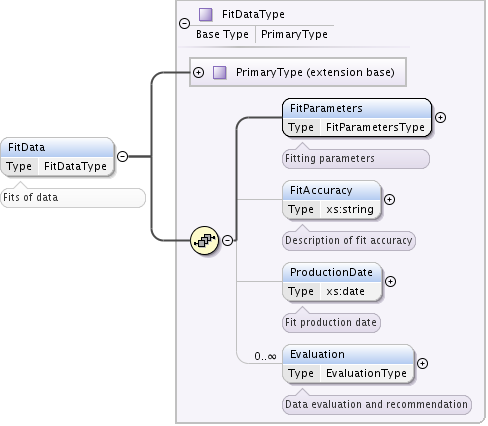
The FitData element of type FitDataType gives all data necessary to calculate the numerical output using a fit function. Function reference should be given in the functionRef attribute of FitParameters element. Validity limits of the arguments (x1, x2...) and the fit parameter values are also provided there.
To complete the description, the fit accuracy, the physical uncertainty and the data production date may be reported.
Extending PrimaryType, FitData defines following elements:
- mandatory FitParameters element, defined by FitParametersType, fully describing the set of parameters needed to calculate function value;
- optional FitAccuracy string element, filled in free format,
- optional ProductionDate element of type xs:date, that may keep the production date of the fit.
- optional list of Evaluation elements, defined by EvaluationType allowing to mark recommended datasets
TabulatedData¶
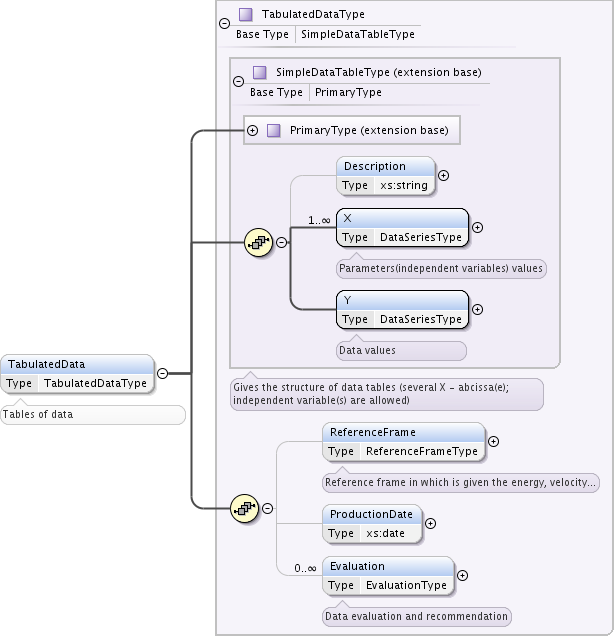
Extending the base SimpleDataTableType, it adds the elements ReferenceFrame, ProductionDate and Evaluation (see description of FitData element for definitions).
ReferenceFrame¶
For numerical data depending on such parameters as energy or velocity, it is important to know in which frame this dependence is calculated. The possible values of the element ReferenceFrame are:
- CenterOfMass
- LaboratoryFrame
- TargetFrame
